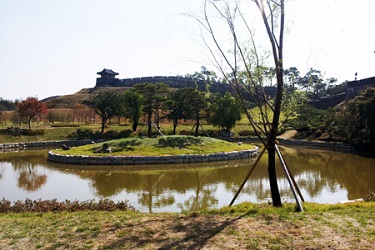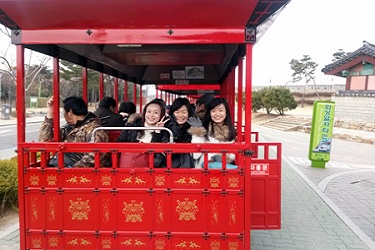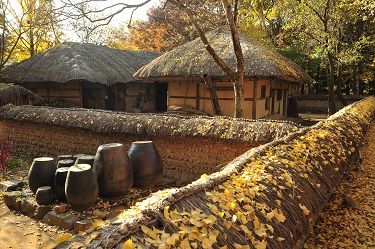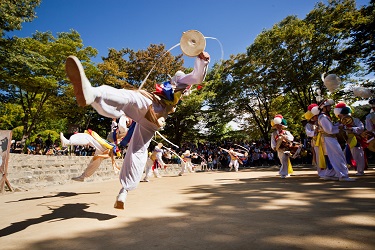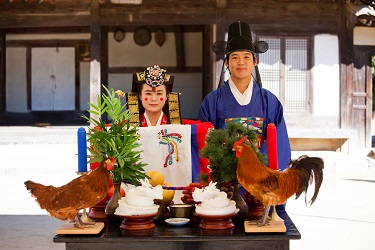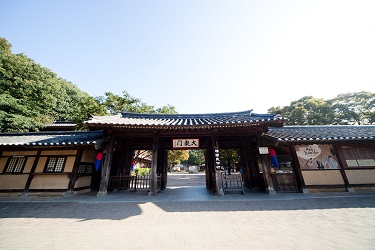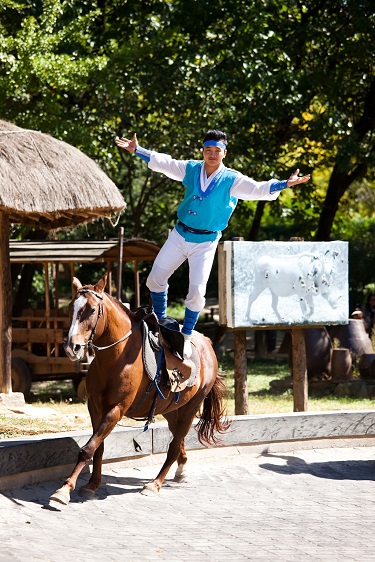Suwon Hwaseong Fortress & Korean Folk Village
Hwaseong Fortress is an impressive structure from the latter part of the Joseon Dynasty (1392-1910) and the official fortress of Suwon-si, Gyeonggi-do. The fortress (constructed from 1794 to 1796) was built as a show of the King’s filial piety towards his father Jangheonseja and to build a new pioneer city with its own economic power. The fortress sprawls over both flat and hilly terrain, something seldom seen in neighboring China and Japan. It is designed to serve political and commercial as well as military functions and is a fine example of oriental fortresses. This one is quite big, probably bigger than tourists’ thought.
After lunch,(mostly Korean traditional food; Bibimbap or Bulgogi) you are moving on to Korean Folk village. It is located in same city, Suwon. There is not only traditional styled housing but also a lot of living things about old days, such as actors/actresses in the clothes of the time. As long as they are spending time talking with you, they will be kindly answering your question, or anything.

|
Full Day Suwon Hwaseong Fortress & Korean Folk Village
Minimum Pax:4 Time Required: 09:00-17:30 Fee: 160,000 won p/p (Including Lunch: Korea Traditional Food) Course: Hotel – Suwon Hwaseong Fortress – Lunch – Korean Folk Village – Ginseng Center or Duty Free Shop – Hotel * We pick you up from your hotel one by one.
|
Suwon Hwaseong fortress
Hwaseong Fortress was constructed as an act of filial devotion by Jeongjo, the 22nd king of the Joseon Dynasty (1392~1910), and to strengthen his power, eradicate party conflict, and fortify the southern area of the capital. Construction was started along Mt.Paldalsan in January 1794 and completed in September 1796 under the supervision of Chae Je-gong, a former minister and the magistrate of Yeongjungchubu County. During construction, equipment such as the Geojunggi, a type of traditional Korean crane, and potters’ wheels were developed and used to transport and assemble large stones. The fortress suffered partial damage during Japanese colonial rule and the Korean War, but most of its original features have been restored with the help of the Hwaseong Seongyeokuigwe, the construction archive published in 1801 after the fortress was completed. The fortress sprawls over both flat and hilly terrain, something seldom seen in neighboring China and Japan. It is designed to serve political and commercial as well as military functions and is a fine example of oriental fortresses.
Korean Folk Village
The Korean Folk Village is home to numerous collections of Korean cultural artifacts, providing an opportunity for Korean children to experience and learn the culture of their ancestors firsthand. The site provides a venue to promote traditional Korean culture to both domestic and international visitors, and provides an open-air learning place for succeeding generations. The village has been developed to convey the wisdom and the spirits of our ancestors to both domestic and international tourists.
The lifestyle of Korean people, with a history extending back more than 5,000 years, abruptly changed following the Kabo Peasant War (1894), the Japanese invasion of Korea (1910-1945), and the Korean War (1950-1953). When the Korean economy surged in the 1960s, the Office of Cultural Properties started to value the establishment and operation of a folk museum. The economy, society, and culture in Korea underwent a tremen-dous change in pursuit of the Saemaeul Movement (movement for regional development), promoted nationwide in the 1970s. During this period, the government, influenced by the Foreigners’ Tourism Promotion Policy, formedan advisory council on January 15, 1972 to research the establishment of the Korean Folk Village. Accordingly, the Korean Folk Village was foundedon May 8, 1973, and the privatization of the Folk Village was officiallyapproved by the government on September 18, 1973.
|
Full Day Suwon Hwaseong Fortress & Korean Folk Village
Minimum Pax:4 Time Required: 09:00-17:30 Fee: 160,000 won p/p (Including Lunch: Korea Traditional Food) Course: Hotel – Suwon Hwaseong Fortress – Lunch – Korean Folk Village – Ginseng Center or Duty Free Shop – Hotel * We pick you up from your hotel one by one.
|
The Important Notice for Tour Reservation
– Please enter your hotel information (such as Hotel name, room number and hotel number) and E-mail address for efficient pick up on the tour day.
– After the reservation, you will receive a confirmation E-mail about the pick-up time and tour information. If you didn’t receive it in 3 days, please remind us to mail@koreatourinformation.com.
Tour Condition
– All the tour includes a tour guide, Transportation (except for walking tour) and admission fee.
– Child Fare: 10 to 30% discount under 10 years old
– If you cancel your reservation on the tour day, 100% cancellation fee will be charged.
– In the morning tour, we drop off all guests at Seoul City Hall.
– We have no responsibility for your personal incidents and losses during all the tour.
– Pick up time might be changed depending on the traffic conditions.
– All major credit cards are accepted in our travel agency.


